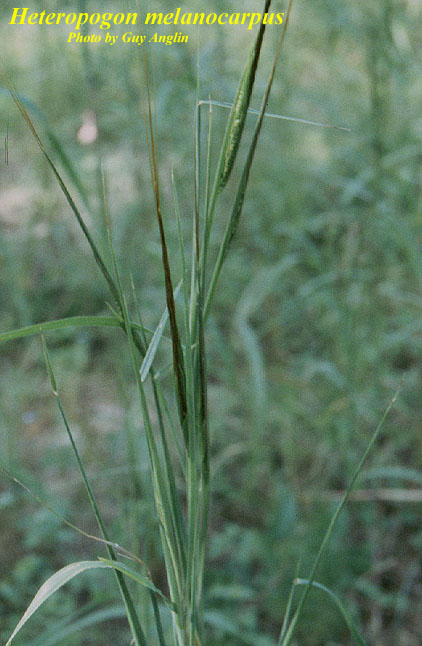Heteropogon melanocarpus
| Heteropogon melanocarpus | |
|---|---|

| |
| Photo by Guy Anglin, Atlas of Florida Vascular Plants | |
| Scientific classification | |
| Kingdom: | Plantae |
| Division: | Magnoliophyta - Flowering plants |
| Class: | Liliopsida – Monocotyledons |
| Order: | Poales |
| Family: | Poaceae ⁄ Gramineae |
| Genus: | Heteropogon |
| Species: | H. melanocarpus |
| Binomial name | |
| Heteropogon melanocarpus (Elliott) Elliott ex Benth. | |

| |
| Natural range of Heteropogon melanocarpus from USDA NRCS Plants Database. | |
Common name: sweet tanglehead, buzzard grass
Contents
Taxonomic notes
Synonyms: none.[1]
Varieties: none[1]
Description
Heteropogon melanocarpus is an annual graminoid.
"Coarse annual; culms 0.8-2 m tall, nodes and internodes glabrous. Leaves primarily cauline; blades to 4 dm long and 1 cm wide, long pilose above in the collar region, margins scaberulous; sheaths glabrous, occasionally glandular, upper inflated, margins usually scarious; ligules membranous, lacerate, 2-4 mm long. Inflorescence glomerate, pedunculate racemes exserted from inflated sheaths. Racemes (excluding awns) 2-4 cm long, sessile spikelet fertile and staminate, pedicellate spikelets staminate. First glume of staminate, pedicellate spikelet asymmetric, one margins winded, glandular punctate, distinctly nerved, acuminate, 12-17 mm long, 2nd glume membarceous,, enclosed by and similar to 1st; fertile and sterile lemmas hyaline, reduced, awn of fertile lemma brown hirsute, twisted, geniculate, to 10 cm long; palea absent; callus appressed brown hirsute, 2-3 mm long. Grain yellowish, linear, terete, 4 mm long." [2]
Distribution
It is found in the southern United States, from North Carolina to Florida and Alabama as well as in Texas and Arizona.[3] It is thought to be naturalized from the Old World, and is widespread in the New World tropics as well as the Old World, north to North America and the southern United States.[1]
Ecology
Habitat
Generally, this species can be found in disturbed areas as well as sandy roadsides.[1] The soils where H. melanocarpus was encountered during the study are fine sandy loams that are poorly drained with slow surface runoff and medium to very slow permeability.[4] It has also been found in wet to dry loamy sand, and seems to prefer semi-shaded to open light conditions. H. melanocarpus can be found in annually burned savannas, as well as in disturbed habitat such as beside trails, roadsides, railroad beds, old fields, and firebreaks.[5] This species tolerates frequent disturbance, since a study found H. melanocarpus as a component of areas that were disked every year in either December or February, and sprouted between June and October.[6]
Associated species include Senna obtusifolia, Conzya pusilla, Strophostyle helvola, Bidens alba, and Andropogon glomeratus.[5]
Phenology
It generally flowers from September until October.[1] As well, it has been observed to flower and fruit from July through November.[5][7]
Fire ecology
This species has been found in annually burned savanna[5] such as the Wade Tract in south Georgia where populations of Heteropogon melanocarpus have been known to persist through repeated annual burning.[8]
It was found only in plots receiving periodic winter burning in Lewis and Harshbarger's experiment.[4]
Conservation, cultivation, and restoration
Due to its distribution being vague, Heteropogon melanocarpus is listed as G4 on the global scale; it is also considered vulnerable in Georgia, and an exotic species in North Carolina.[9]
Cultural use
Photo Gallery
References and notes
- ↑ 1.0 1.1 1.2 1.3 1.4 Weakley, A.S. 2020. Flora of the Southeastern United States. Edition of 20 October 2020. University of North Carolina at Chapel Hill, Chapel Hill, North Carolina.
- ↑ Radford, Albert E., Harry E. Ahles, and C. Ritchie Bell. Manual of the Vascular Flora of the Carolinas. 1964, 1968. The University of North Carolina Press. 166. Print.
- ↑ USDA, NRCS. (2016). The PLANTS Database (http://plants.usda.gov, 22 May 2019). National Plant Data Team, Greensboro, NC 27401-4901 USA.
- ↑ 4.0 4.1 Lewis, C. E. and T. J. Harshbarger (1976). "Shrub and herbaceous vegetation after 20 years of prescribed burning in the South Carolina coastal plain." Journal of Range Management 29: 13-18.
- ↑ 5.0 5.1 5.2 5.3 Florida State University Robert K. Godfrey Herbarium database. URL: http://herbarium.bio.fsu.edu. Last accessed: June 2014. Collectors: Loran C. Anderson, R. Komarek, James R. Burkhalter, R. K. Godfrey, James D. Ray Jr., A. H. Curtiss, Robert L. Lazor, Norlan C. Henderson, A. F. Clewell, R. A. Norris, R. F. Doren, Angela M. Reid, and K. M. Robertson. States and Counties: Florida: Bay, Columbia, Duval, Escambia, Hernando, Jefferson, Leon, Santa Rosa, Taylor, and Wakulla. Georgia: Grady.
- ↑ Kay, C. A. R., et al. (1978). "Vegetative cover in a fallow field: Responses to season of soil disturbance." Bulletin of the Torrey Botanical Club 105(2): 143-147.
- ↑ Nelson, G. PanFlora: Plant data for the eastern United States with emphasis on the Southeastern Coastal Plains, Florida, and the Florida Panhandle. www.gilnelson.com/PanFlora/ Accessed: 22 MAY 2019
- ↑ Glitzenstein, J. S., D. R. Streng, R. E. Masters, K. M. Robertson and S. M. Hermann 2012. Fire-frequency effects on vegetation in north Florida pinelands: Another look at the long-term Stoddard Fire Research Plots at Tall Timbers Research Station. Forest Ecology and Management 264: 197-209.
- ↑ [[1]] NatureServe Explorer. Accessed: May 22, 2019